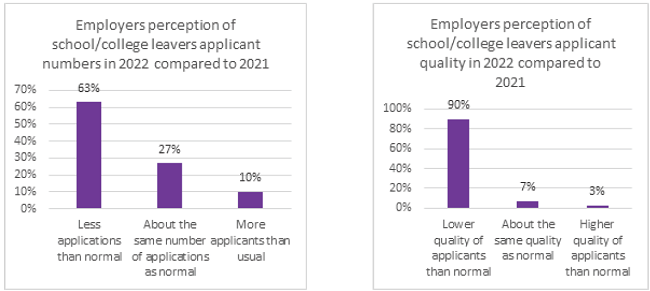While graduate recruitment fell during the pandemic, apprentice recruitment stayed strong, ISE’s Stephen Isherwood explains why.
National Apprenticeship Week offers a chance to celebrate all things apprentices. One of the most interesting developments in this field has been that while member graduate recruitment dipped during the pandemic, apprentice recruitment stayed strong.
To explore why apprentice recruitment stayed strong during the pandemic, we start with some stats. ISE research shows growth in school leaver and apprentice hires of 7% in 2020, 14% in 2021 and projected hires up by 17% in 2022.
It looks good doesn’t it? But this is ISE member data and our members are the larger employers with well-resourced HR teams who are probably have the biggest levy pots. The national picture of apprentice recruitment is not so positive.

Despite the government’s Covid-19 incentive for apprentice employers of £3k for new hires, overall apprentice starts are down on pre-pandemic levels and still significantly down compared to the pre-levy period. So why is ISE data bucking the national trend? I can think of three possible reasons:
- The typical ISE member has a higher than average levy bill so is more likely to seek to use the apprentice route. Despite the pressures of the pandemic, their levy pot was available to invest in apprentice starts.
- With established programmes in place and an eye to the future labour market, employers know that to reduce early talent hiring during a recession can cause resource problems when the economy recovers. Employers won’t have enough people coming through into junior management positions to take advantage of increased business opportunities if they cut back now.
- That the levy is complex to navigate might actually have deterred many employers from cutting back on the programmes. Having invested considerable resources in getting an apprentice programme up and running there will have been less incentive to significantly reduce apprentice hiring.
The challenge of attraction
Where apprentice employers do have a problem is in attracting applicants.
As a response to Covid-19 problems the government lifted the cap on university places, which means the focus of college and school students was even more weighted towards university options than usual.
It’s no surprise then that employers tell us that the quality and volume of apprentice applications has fallen further than for graduates. The majority (90%) of employers in our recent Vacancy Survey said that apprentice and school leaver application quality is down year on year.

Does this mean the government is going to reform the levy any time soon?
This is unlikely as the levy large employers pay, funds apprentices at non-levy paying employers and the total pot is fully spent.
The levy is a payroll tax and any additional funding would have to come via the treasury who have many other demands to meet.
The recent levelling up white paper discusses apprenticeships in only the broadest sense and it is over two-and-a-half since Auger’s Post-18 review of education and funding was published.
Be in no doubt though that apprenticeships are here to stay. Whilst there may be no new money around, the skills agenda is integral to many government policies and has broad cross-party support. Many employers still aren’t spending all their levy funds or have yet to build an apprentice programme. So there is still considerable room for growth.
For more insights on how to make best use of apprentices book your place at the ISE Delivering Apprentices Conference on 23/24 February.


0 Comments